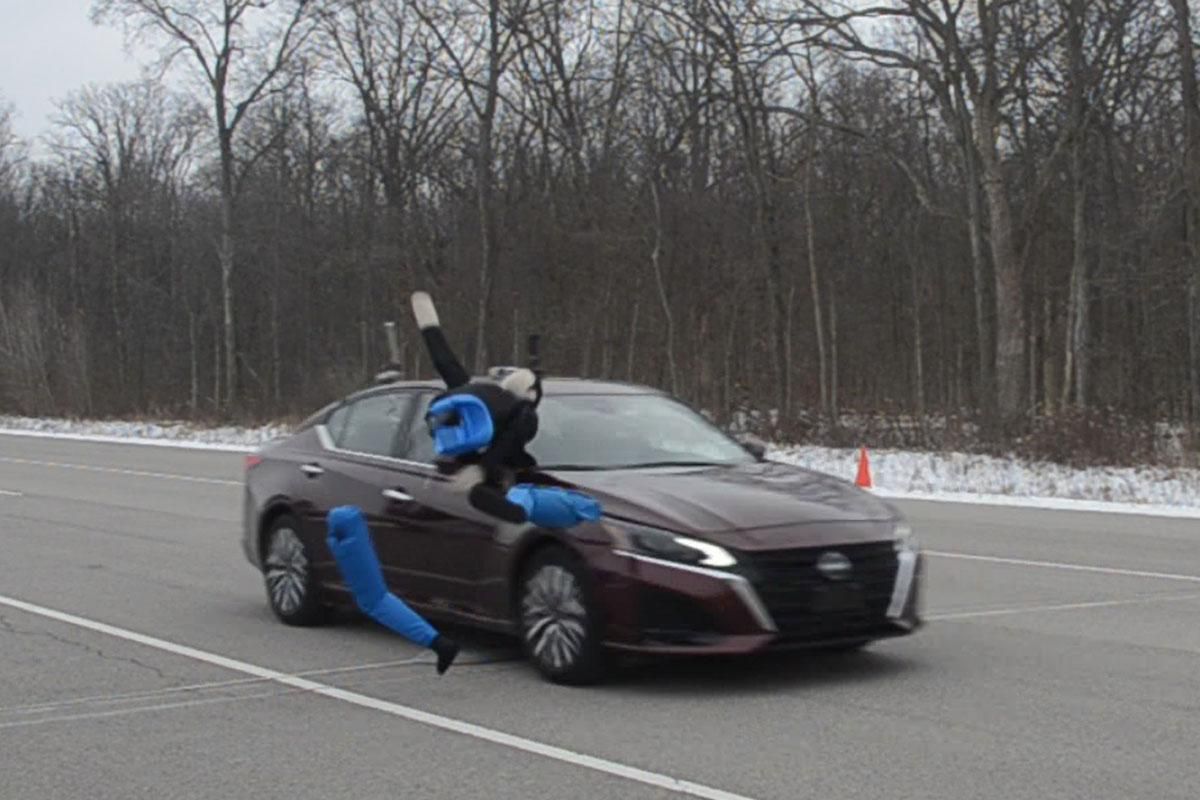To some extent, the white paper published in July by Ascential Technologies offered something most people in the industry already understand: Advanced driver assistance systems (ADAS) that are not properly calibrated and aligned aren’t likely to function as designed. The report summarizes crash testing commissioned by Burke Porter — an Ascential Technologies brand — at the Transportation Research Center of a 2024 Nissan Altima to evaluate the effects of various calibration methods on the vehicle’s forward-facing radar and camera-based features.
“Improper calibrations led to significant degradation in system performance, including failure to meet key criteria in lane departure warning, forward collision warning, crash imminent braking and pedestrian automatic emergency braking scenarios,” the white paper said, with images of the test vehicle rear-ending a target vehicle and sending pieces of a struck pedestrian dummy flying. “In contrast, calibrations performed under controlled and precise conditions consistently met or exceeded the performance benchmarks.”
But speaking at the recent Collision Industry Conference (CIC) in Philadelphia, Brunno Moretti, president of ADAS solutions at Ascential Technologies, shared some of the testing findings that seem a little more unexpected: namely, that the vehicle performed even worse in the testing before anything was done to it.
Moretti said the company purposely chose a test vehicle that wasn’t brand new. The Altima had 13,000 miles on it, but had not previously been involved in a collision or been repaired.
“We wanted to make sure it was a vehicle that had some wear and tear, that maybe had hit some potholes, and 13,000 to 15,000 is I think what the average American drives in a year, so we think this vehicle was very representative,” Moretti said.
Prior to testing the vehicle with both good and bad ADAS calibrations being performed, it was tested as-is, and the vehicle failed to stop before hitting a target in four of the seven tests.
“The good calibration outperformed the baseline, but the big surprise was even a poor calibration outperformed the baseline,” Moretti said. “To me, that tells you that there’s enough wear and tear on a vehicle after 13,000 miles that there is drift in the brackets or something. That opens the door to talk about calibrations as a maintenance item. Because as these systems are on the road, there are things that are happening — that are not collisions — that are knocking these systems out of whack.”
 Brunno Moretti, right, of Ascential Technologies was interviewed on stage by Aaron Schulenburg, left, at the recent Collision Industry Conference (CIC).
Brunno Moretti, right, of Ascential Technologies was interviewed on stage by Aaron Schulenburg, left, at the recent Collision Industry Conference (CIC).
“ADAS components are subject to vibrations, thermal expansion and aging just like any other part,” the Ascential white paper said. “Over years of use (or exposure to potholes, curbs and harsh weather), cameras and radar brackets can slowly shift or loosen from their original factory alignment. Moreover, age-related wear and tear, or something like a windshield developing a minor distortion where the camera looks through, can degrade sensor performance.”
The white paper also notes, however, that the Highway Loss Data Institute found “Subarus and Hondas with ADAS continued to show the same lower crash claim rates even when the vehicles were 5+ years old, implying their systems were still functioning well,” which suggests “that catastrophic drift is not inevitable in the short term.”
Moretti also made clear at CIC that efforts made in the testing to conduct improper calibrations were not designed to ensure the system did not perform. Rather, those calibrations were conducted “using what we know people do,” such as “calibrating outside, on uneven floors, with the target not aligned to the center [of the vehicle], or the fuel tank not full when it was supposed to be.”
“We heard from a dealer that they calibrate the radar with the garage door opening, that’s their flat plate,” Moretti said. “So that’s how we calibrated it. We had slight modifications to the sensors. In this vehicle specifically, you can clamp the camera into the bracket incorrectly, and it’s off by a few degrees. And that happens all the time.”
In testing the vehicle with the improper calibrations, “The system was off. It might as well not had it,” Moretti said. “It did not engage alerts. It did not engage brakes, as you can see in the video. It didn’t do anything. Even with a big target, like a vehicle, it did not see it, it didn’t do what it is intended to do.”
Moretti said he’s concerned that in terms of improper calibrations, the industry is going to have another “John Eagle Collision moment,” referring to the 2017 multi-million-dollar lawsuits against a Texas dealership and an insurer based on a couple’s life-altering injuries after an accident in an improperly repaired vehicle.
“There’s going to be a massive lawsuit, and [only then] are people going to be paying attention,” Moretti said.
He acknowledged the testing and white paper looks only at one study of one vehicle, but he feels it “sheds a light into this and how important it is, and that we need to do more work, do more research and get more data to really quantify this problem.” But such testing isn’t cheap, he said, noting the one test cost about $100,000.
He also noted that calibrations offer collision repairers a way to “make more revenue for your shop by doing the right thing.”
“You're doing the right thing for the customer, you’re doing the right thing for vulnerable road users,” Moretti said. “It's just a very interesting intersection where doing the right thing is actually going to make you more money.”













John Yoswick